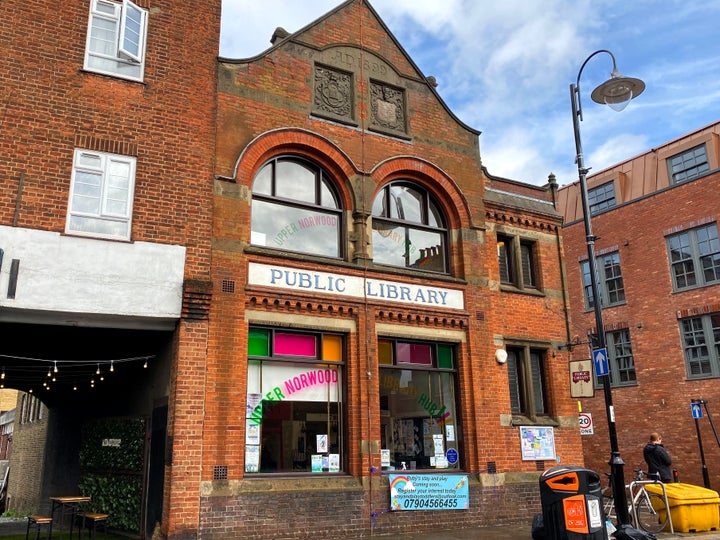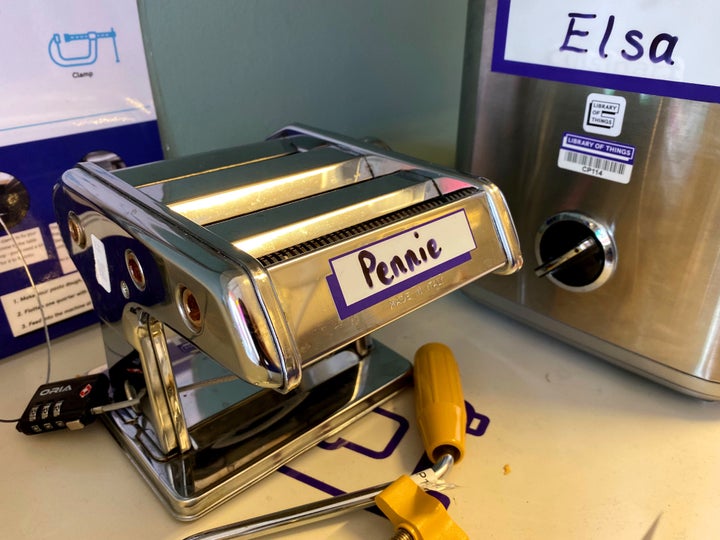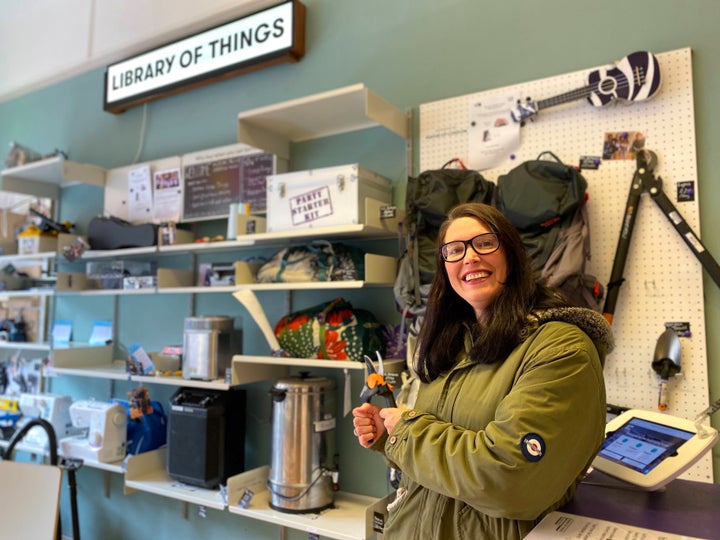
As I walk into Upper Norwood library, I’m struck by how un-library-like it is. Rather than a quiet, unassuming space, the room is teeming with life, from the parent-and-toddler group who are sitting in a circle singing at the back to the elderly people slowly perusing the book aisles.
I’m not here to borrow books today – or to sing (more’s the pity). Instead, I’m checking out the Library of Things, a scheme run from the front room of the building where you can borrow household items and appliances rather than books.
Inside there’s a wall of shelves lined with various household items that you can borrow for a period of up to two weeks. On the day I visit, there’s an eclectic mix of items including a couple of sewing machines, an electric saw, three hiking backpacks, a waffle maker, a ukulele and a ‘party starter’ kit, which includes some delightful-looking disco lights.
Locals pay £1 to join and can then reserve items to borrow online. They collect their chosen item from the library in person and pay a set amount per day to borrow it: a set of Allen keys cost as little as £1 a day, where as the carpet cleaner will cost £20 a day – I’m told the latter is very popular.
Items are collected from a self-serve kiosk at the front of the library. “It’s like a Santander bike,” explains Rebecca Trevalyan, co-founder of Library of Things, who runs it full-time. “You get a code to unlock your projector or your lawn mower and then you take it away, receive your how-to guides and videos direct to you, and return it on the day you’ve agreed.”
She tells me there have been nearly 2,500 ‘borrows’ since it launched in April 2018, with over 2,000 people signed up to use the service. Most of them are local, she says, with 80% living within a mile of the library.

The primary reasons people choose to borrow rather than buy, are to do with space and cost per use. “You don’t have to clog up cupboards and spend money on things that you’re going to use twice a year,” says Trevalyan, who is 29.
“Increasingly, the secondary motivation is: ‘I want to support the environment’,” she continues.
It’s estimated that 170 million new electrical items are purchased in the UK each year, however less than a third of these are recycled, meaning an awful lot of items end up in landfill. Borrowing schemes help reduce the number of items purchased and therefore lowers the number sent to landfill. By borrowing, locals are also reducing their carbon footprint as they’re no longer buying online and having an item delivered. “We can’t just keep buying more appliances,” says Trevalyan.
She came up with the idea for Library of Things alongside her friends Emma Shaw, 29, and Sophia Wyatt, 28, when they were at university. What started out as a passion project evolved into something much more. “We were students living in small apartments without much space for stuff, without money to buy stuff,” she says. “We were really thinking we need the hole in the wall, not the drill. We need music at our party, not a massive sound system.”
And so the Library of Things was born (after a lot of hard work). The Crystal Palace branch is mainly used by young families and millennials – people who don’t have disposable income to buy bigger items, nor the space in their homes to keep them.
One in five customers classify themselves as from a low-income household, says Trevalyan, which gives them a specific membership and extra discounts when borrowing.
When I visit, there are multiple people browsing the shelves – some are picking up items they’ve reserved, others are simply having a look at what’s on offer. Rose Donnelly, who is 45 and lives just around the corner from the library with her cat, Iggy Pop, is borrowing some secateurs to cut down overgrown brambles outside her home.
“It seems silly to go and spend money on something new which you’re going to use once or twice a year,” she says. Donnelly is also planning to borrow a carpet cleaner and pressure washer in the near future. Meanwhile Geoff Morley, a volunteer at the library who is semi-retired, borrowed the party starter kit for £8 and used it for his New Year’s Eve party – his face lights up when he tells me about it.

Items have been provided free of charge, or at heavily discounted prices, by manufacturers. Once borrowers have returned them, they’re invited to get more involved with the scheme by joining an event like a DIY class or “repair party” (where they learn how to repair items). In some ways it’s so much more than an outlet to borrow from, it’s fighting loneliness too.
One borrower in his fifties had been socially isolated for a couple of years, says Trevalyan. “He came into the Library of Things one day to borrow a strimmer for his allotment and saw a notice advertising the volunteer role of ‘thing fixer’ and he’s since got involved on Monday nights helping to repair items. He now has a big network of people around him.”
One in 10 borrowers choose to get more involved either through volunteering or skill-sharing sessions, says Trevalyan. “Their motivations generally are to make friends and to feel a part of the place they live, to feel like they’re contributing.”
It’s clearly an overwhelmingly positive addition to the community – the perfect mixture of giving back and helping the environment. And there will be six more Library of Things projects opening in the next 18 months, although Trevalyan remains tight-lipped on where they’ll be. “The hope is to work with communities in cities across the UK,” she adds.
“For communities, buying more stuff isn’t working. We keep hearing the phrase ‘high street crisis’ and that shopping is shifting online, so we need to find new activities and services that bring people together in their neighbourhoods and on their high streets.”
People interested in launching a Library of Things locally can find out more here.